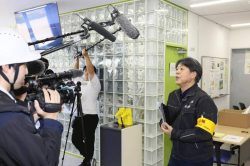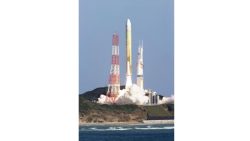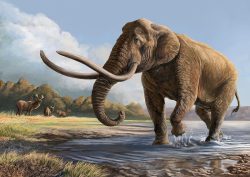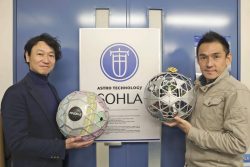
The asteroid Dinkinesh, a denizen of the solar system’s main asteroid belt, is seen in multiple images taken by the NASA Lucy Spacecraft’s L’LORRI Instrument. Panels a, b and c each show stereographic image pairs of Dinkinesh in the minutes around closest approach on Nov. 1, 2023.The yellow and rose dots indicate the trough and ridge features, respectively. These images have been sharpened and processed to enhance contrast. Panel d shows a side view of Dinkinesh and its satellite Selam taken a few minutes after closest approach.
13:33 JST, June 27, 2024
WASHINGTON (Reuters) — A little asteroid called Dinkinesh — visited last November by NASA’s Lucy spacecraft — has a surprisingly dynamic history, according to scientists, along with its moonlet Selam that is comprised of two bodies that gently melded into one.
Dinkinesh and Selam are the smallest asteroids from our solar system’s main asteroid belt, located between the planets Mars and Jupiter, ever seen up close by a spacecraft. Lucy observed ridges, trough structures and other characteristics on Dinkinesh that hint at a complicated past for the asteroid and its companion, the researchers said on May 29.
Asteroids are primordial remnants from the solar system’s early stages, offering clues about how Earth and other planets formed roughly 4.5 billion years ago.
The U.S. space agency launched Lucy in 2021 on a 12-year mission to study asteroids — in particular, Jupiter’s Trojan asteroids, two batches of space rocks that lead and trail the giant planet as it orbits the sun. On the way, Lucy flew past Dinkinesh and Selam in the inner edge of the main asteroid belt.
Dinkinesh has a diameter of 720 meters. Selam is made up of two similarly sized lobes, one 230 meters wide and the other 210 meters. Selam orbits Dinkinesh once about every 53 hours at a distance of about 3.1 kilometers.
It appears, the researchers said, that a big piece of rock broke free sometime in the past from Dinkinesh, amounting to about a quarter its total size, as the asteroid spun in its orbit, gouging a trough on its surface and sending debris into space. Some of this debris, they said, apparently fell back onto Dinkinesh’s surface as boulders to form a ridge structure, while other material came together to form Selam.
Selam is what is called a contact-binary moonlet.
“When referring to small bodies in the solar system, a contact-binary is when it appears that a single body is composed of two objects that collided gently enough not to become disrupted,” said planetary scientist Katherine Kretke of the Southwest Research Institute (SwRI) in Colorado, a coauthor of the study published in the journal Nature.
“They are relatively common in the solar system, but Selam was the first time a contact-binary has been observed orbiting another asteroid,” Kretke said.
Dinkinesh orbits the sun at about 2.2 times the distance of Earth’s orbit.
“During their lifetime, small asteroids may shed material, which later ends up forming a small satellite or satellites. The complex shape of Selam indicates that this process may occur multiple times,” said SwRI planetary scientist and Lucy mission deputy principal investigator Simone Marchi, another study coauthor.
Asteroids are the building blocks of planet formation.
“A planet like Earth formed by the accumulation of countless small bodies. Understanding the properties of small asteroids such as Dinkinesh and Selam helps us to have a better picture of the earliest phases of planet formation,” Marchi said.
NASA’s spacecraft was named for the Ethiopian fossil, nicknamed Lucy, of the extinct human relative Australopithecus. That fossil has provided insight into a formative stage of the human evolutionary lineage, much as asteroids provide insight into planetary formation.
Dinkinesh is the Ethiopian name for the Lucy fossil, meaning “you are marvelous” in the Amharic language. Selam, the Ethiopian name for another Australopithecus fossil, means “peace” in Amharic.
Lucy will next visit the asteroid Donaldjohanson in 2025 in the main asteroid belt, with 11 asteroids in total on its agenda. The Dinkinesh visit was a late addition to Lucy’s itinerary.
“Dinkinesh was a test fly-by for the Lucy mission that allowed us to exercise some of the procedures that will be used later in the mission when we get to the Trojan asteroids,” Marchi said. “Lucy performed flawlessly and as planned.”
"Science & Nature" POPULAR ARTICLE
-

‘Fiercest, Most Damaging Invasive Weed’ Spreading in Rivers, Lakes in Japan, Alligator Weed Found in Numerous Locations
-

Univ. in Japan, Tokyo-Based Startup to Develop Satellite for Disaster Prevention Measures, Bears
-

Tsunami Can Travel Vast Distances Before Striking, Warn Japanese Researchers
-

Japan’s H3 Rocket Failed in Latest Launch, Says Official
-

Japan’s H3 Rocket Likely Made 1.5 Trips Around Earth; Analyst Believes Satellite Almost Certainly Lost As Well
JN ACCESS RANKING
-

Japan Govt Adopts Measures to Curb Mega Solar Power Plant Projects Amid Environmental Concerns
-

Core Inflation in Tokyo Slows in December but Stays above BOJ Target
-

Major Japan Firms’ Average Winter Bonus Tops ¥1 Mil.
-

Tokyo Zoo Wolf Believed to Have Used Vegetation Growing on Wall to Climb, Escape; Animal Living Happily after Recapture
-

JAL, ANA Cancel Flights During 3-day Holiday Weekend due to Blizzard
























